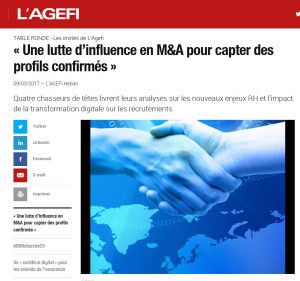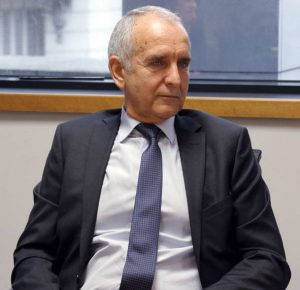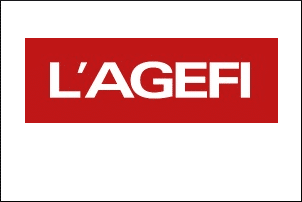Round table, Agefi and 4 headhunters (EN)
TABLE RONDE – Les invités de L’Agefi
Employment News 03/09/2017 L’AGEFI Weekly:
“A Real Battle for Influence in M&A to Attract Young Experienced Bankers”
Four headhunters share their insights on the new HR challenges and the impact of digital transformation on recruitment.

Guests:
Denis Marcadet, Vendôme Associés
Danielle Nassif, Kienbaum Consultants International
Delphine Dubreuil, Singer Hamilton International
Christophe Blanc, Traditions & Associés
What trends have been driving the finance executive job market since the beginning of the year?
Denis Marcadet – After several years of extreme sluggishness, except for control/risk/compliance roles, we are seeing a resurgence in activity in corporate and investment banking (CIB). Paris is once again recruiting, and not just junior profiles, which were the only ones sought after in recent years; this includes client relationship support functions, such as coverage. This applies to both French banks – a new development as they are not lacking internal resources – and foreign banks. Transactional and debt roles are also active: specialized financing and DCM (debt capital market) activities offer opportunities. Private debt, through specialized funds, is experiencing strong growth and there is demand. In M&A (mergers and acquisitions), demand remains steady, particularly for mid-level roles like vice presidents (VPs, six to nine years of experience) and directors (ten to fifteen years of experience). Additionally, in market front-office roles, after years of shrinking Parisian teams, we are seeing demand, especially on the sales side. A new chapter is beginning: after a period of questioning, there is now a concrete search for talent. This is even true in trading (for experienced profiles, with seven to eight years of market experience), which is rare and noteworthy, although on a very limited scale. Both French and foreign institutions are involved, and boutiques are attractive. Added to this are post-Brexit considerations and the expressed, but not yet finalized, intentions of some foreign institutions to either consolidate or establish a stronger presence in Paris.
Danielle Nassif – Simultaneously, we note that in 2017 there is still a strengthening of all functions related to regulation, compliance, control, internal audit, and risk. This has been the case for several years now, but a new trend is emerging: a stronger demand for expertise and specialization in specific aspects of risk, for example. Previously, financial institutions sought generalists or professionals from other functions who could transition into these roles. Now, these roles have become more sophisticated. Banks, particularly CIBs, need people in these roles who understand the business and can help operational staff find solutions and support them. Additionally, we see consulting firms developing regulatory, compliance, and risk practices and recruiting from banks, insurance companies, or regulatory authorities (Prudential Control and Resolution Authority, Financial Markets Authority).
Delphine Dubreuil – In these risk, compliance, control, etc., roles, the profiles chosen in recent years were not always able to support the business rather than simply constrain it. Their role was limited to giving a green or red light. Now, banks, particularly CIBs, are trying to promote professionals to these roles who understand the operations developed by different departments and can help operational staff find solutions to regulatory and risk issues.
Returning to M&A, execution teams are facing a now visible phenomenon: a shortage of mid-level profiles (a generational gap linked to the 2008 crisis), aged around 28 to 33 years, who hold the positions of associates, VPs, and directors. In many structures, the age pyramid is inverted with an overrepresentation of originators (senior bankers and managing directors) compared to younger staff. Boutiques particularly need to attract these associate and VP profiles to ensure the smooth running of their transactions. We are witnessing a real battle for influence to capture these profiles, leading to a significant increase in salaries. However, it should be noted that in Paris, M&A salaries tend to normalize. They no longer reach the levels of twenty years ago. This drives bankers to take a different view of their career choices and the human quality of the structure they join, as the job remains very demanding and requires a lot of commitment, especially at the beginning of their careers.
Christophe Blanc – In M&A, I notice a marked trend in talent search that is less driven by the traditional major players we all know, the investment banks, and more by independent boutiques and audit and consulting firms. The same goes for corporates, which for several years now have been commissioning us to create or strengthen their internal M&A teams. I imagine this movement can be explained by a desire to rely less on bankers or, in any case, to better control the execution process internally. As a result, the recruitment market is extremely favorable for well-trained young seniors (VPs). In the current configuration, they have the choice of employer and clearly dictate the market. The signals are very apparent, especially since, beyond the transfers of M&A bankers to corporates, others do not hesitate to turn to entrepreneurial projects. The inability of young M&A professionals to project themselves long-term in this profession should compel investment banks to reconsider the careers they offer their employees.
Is there a cultural shift happening among the younger generation of financiers?
Danielle Nassif – Yes, undoubtedly. Digital transformation has amplified this change in mentality, but other factors have contributed in recent years. Firstly, the regulation of compensation in the banking sector. With more constrained and reduced bonuses, the rules of the game have changed for bankers, especially those in M&A. Previously, their individual investment (long hours, availability at all times, including weekends and holidays) was generously rewarded, and there was a tacit contract: work hard, get financially rewarded. But with the introduction of European rules on bonuses in banks (bonuses have been capped in Europe since 2015), this contract is void… Another recent factor is pushing young executives in traditional finance to question their careers: the arrival of new entrants, like Orange Bank, which threaten well-established and long-standing business models. In this context, young “classic” bankers are questioning the sustainability of their profession and are increasingly attracted to smaller or mid-sized structures, whose work environment better meets their expectations.
Denis Marcadet – This is a real HR issue for banks, especially as roles evolve and change. Young people want to be inspired. It is up to financial institutions to make themselves attractive. To this end, adapting or even rethinking their social business model to reintegrate young people into continuity is a priority. There has been a cycle break. Social plans, lack of functional and geographical mobility, compensation constraints in an ultra-regulated market, and a stagnant or non-existent market have led young executives to reconsider their career and sector choices, as well as their professional future. Many no longer see themselves in their profession or in a banking company, which is considered too rigid in its functioning, organization, and hierarchical system. The appeal of smaller, more human-sized structures, or even entrepreneurship, is strong. Faced with this, organizations must redefine the environment in which they want to grow this young generation. Additionally, companies must consider the weight of intergenerational dynamics. In a context of changing organizations, tools, behaviors, and roles, making different generations with disparate skills coexist and motivate each other is a fundamental issue. Between fifty-year-olds, thirty-year-olds, and twenty-five-year-olds, there are neither the same skills, professional fundamentals, nor expectations… Their understanding of a professional career is different; finance thirty years ago is not the finance of today. HR departments must embrace this social mosaic to make these different population types interact and create connection and motivation. They need to inspire the young, but also maintain and nurture the dreams of other categories. This is where the banking sector, which focuses its HR attention on the 25-35 age group (increasingly volatile), at the expense of others, puts itself at risk.
Delphine Dubreuil – It is true that millennials, as the now established term goes, are less interested in careers in financial services due to less significantly attractive compensation compared to the 1990s-2000s. HR policies must take this into account and place more importance on long-term career management. Their vision was previously more short-term focused. Finance may have been less attentive than other sectors to the notion of “employer branding” and the attractiveness it must generate among juniors starting their professional journey. There is still much to be done to understand the expectations of new generations to counter the competition from the new economy. And indeed, as Danielle Nassif says, human-sized entities are favored by young financiers: in asset management, I see many who are enthusiastic about entrepreneurial projects.
Christophe Blanc – Indeed, I believe that the generation of graduates at the beginning of the financial crisis faced the greatest difficulties in finding sustainable employment in the financial industry. Moreover, they have witnessed, and continue to observe, the more or less “forced” departures of their elders as part of restructurings. Finally, given the sector’s transformation and its business model, yesterday’s career paths can no longer be the same, and no one today is capable of making forecasts in this area. As a result, young finance professionals no longer have long-term expectations of their employer and try as much as possible to take their destiny into their own hands. They do not hesitate to “change careers,” join another sector, or start their own business.
 What impact does digital transformation have on the profiles sought in finance?
What impact does digital transformation have on the profiles sought in finance?
Denis Marcadet – In the context of the “digitalization” of retail banking activities, the particularly sought-after populations are clearly engineers and mathematicians. There are a few “marketers,” but quite few. The transformation context highlights the need to strengthen data security functions, which are key in “digital” issues. Certain roles are in demand, notably senior business analysts, and the market is active for them; to a lesser extent, CDOs (chief digital officers) are also in demand. However, the masterminds of digital transformation in banks are rarely internalized, and when they are, they are recruited from the digital ecosystem rather than from fellow bankers. The consequences of these changes are multiple; on the retail side, previous sales teams no longer meet future needs. To attract and motivate new generations, intrapreneurship and project-based work organization are offered, far from the previously practiced models. Finance is adapting its rules, tools, and user profiles. Traditional companies must know how to manage the transformation of their roles as well as the transition of their workforce…
Danielle Nassif – I observe that this year, transformation roles are at the heart of concerns for banks and insurance companies; chief digital officers (CDOs), and now chief data officers, have become more sophisticated in terms of profile types. Our clients are showing more openness to the sectoral background of candidates, whereas we previously often recruited from bank to bank for these roles. Banks have every interest in this. They have talent pools, but if they want to gain a fresh perspective and expand this talent pool, they need to look towards sectors that are more mature in “digital.” There are many search criteria and client demands; they want a candidate who already has knowledge in “digital,” who might know a bit about the finance sector to avoid discovering it completely, who has worked in a large traditional group but also has start-up or entrepreneurial experience to bring a disruptive spirit. To attract these non-financial profiles, I think that structures that are less mature in terms of “digital” growth have attractive projects to offer. These candidates will indeed be able to quickly measure their impact instead of being diluted in the “mass” of a large financial institution.
Christophe Blanc – I note a form of groping in “digitalization” and the search for new talents to lead it. I am sometimes a bit surprised by the lack of vision our clients have on this subject. They know they need to move to “digital” transformation, but it is clear that they themselves do not yet fully understand what this implies in terms of changes and consequences for their activities. So today, beyond a candidate’s know-how, large institutions are also looking for their vision. They are seeking someone who will show them what their “digital” transformation will really be. Some insist on choosing a profile with a fine knowledge of the banking/financial industry, but there is a real trend to seek skills and professional experiences from other sectors, notably retail.
Delphine Dubreuil – Here, we are clearly in a subject where the role of the headhunter or recruitment consultant is crucial. We talked about “lateral thinking,” these are recruitment strategies that need to be built. I think these “digital” profiles, those who define and lead “digital” strategies, are evolving profiles that can be identified within the organizations themselves, with executives who have built their careers over ten, fifteen years, transversally, on transformation projects involving operations, risks, regulations, information systems… Ultimately, they arrive at “digital” quite logically, knowing perfectly well the workings of the roles they have dealt with. In this context, the headhunter’s role is to develop a strategy to identify this type of transversal profile and assess their ability to take on a role in “digital” transformation.
Interviews conducted by the editorial team on February 16.
Visit L’Agefi’s website for more articles:



